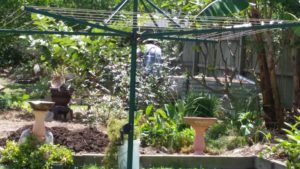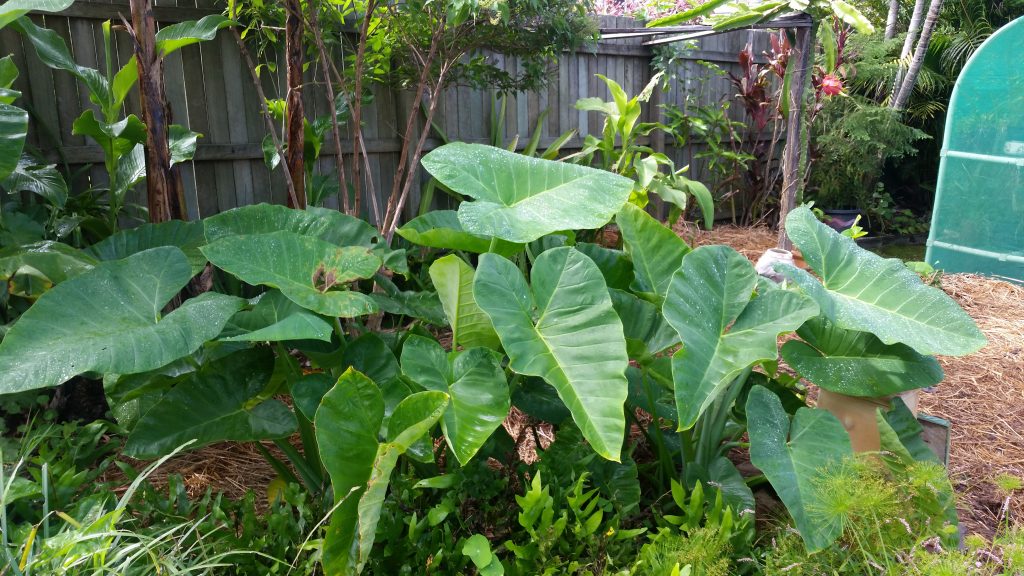Recently I posted an offer to supply plants and seeds to people wanting to grow food and unable to buy seeds or seedlings. I add here the details about many of the plants I can supply, as they are sometimes unusual or not well known. Sadly the pics have not come through I will try to fix this soon. 
| Ceylon Spinach
grows as a warm season annual in most parts of Australia. In summer, Ceylon Spinach is at its best. The leaves taste similar to ordinary spinach although somewhat mucilaginous and they can be harvested regularly to be eaten raw or cooked. |
Brazil Spinach
Brazilian spinach is a low growing perennial that will extend over a large area if allowed. It’s easy to control though through regular harvesting of the tips. Likes a regular supply of water, but will hold its own in drought conditions – leaf production will slow down. Propagation is by tip cuttings which root easily, or the plant can be divided at the base. |
Taro
Taro is a starchy root crop with edible leaves. Taro root’s rich source of nutrients, include potassium, calcium, magnesium, phosphorus, folate and fibre. It contains antioxidants, as well as vitamins C, B and E. Don’t forget the taro leaves —a wonderful source of fibre, protein, calcium, iron, magnesium, phosphorus, vitamin A, vitamin C and folate! |
Coco Yam
Cocoyam has better nutritional qualities than other root and tuber crops such as cassava and yam, with higher protein, vitamin and mineral content. A versatile staple, cocoyam can also be used as weaning food, while the leaves can be cooked as vegetable. Lends itself to savoury and sweet dishes. |
| Aloe Vera
Aloe Barbadensis Aloe Vera is a subtropical plant of the Asphodeloideae family well-known as burn remedy. Take internally to heal ulcers.
|
Oregano
Culinary herb Use in sauces, on pizza and in savoury dishes. Will form a clump. Keep watered in dry weather.
|
Parsley leaf is rich in vitamins and minerals, particularly vitamins A and C, and compounds that clear toxins from the body.
Parsley root has been used medicinally since ancient times for digestive disorders, bronchitis, and urinary tract problems |
Nasturtium
Brightly coloured orange, yellow and red flowers, will run and spread under trees and over embankments. All parts edible. Seeds make caper substitute. Annual. Sow Spring and Autumn. |
| Chickweed
Stellaria media
Semi-wild ground cover plant with many therapeutic and nutritional values. Will self- seed and come up wild in the garden.
|
Sambung
Gynura procumbens (Also called Mollucan Spinach) Widely used in Asia for therapeutic benefits. Medicinal qualities include anti-inflammatory, anti-allergic. Grows readily from cuttings
|
KANG KONG
Ipomoea aquatica
Kang kong is a good source of amino acids, calcium, iron, vitamins B and C. Loves water, grow next to dam or pond. Grows readily from cuttings
|
Gotu Kola
. Centella asiatica Used as a medicine for thousands of years in India, China, and Indonesia, particularly for healing wounds, improving mental function. Anti-inflammatory. Running habit, will spread if not kept in check. |
| Lebanese Cress
Aethionema cordifolium Loves damp conditions, Plant under a tap or near pond. Tasty addition to salads.
|
Dog Bane
Hardy succulent with purple flowers Pungent smell, reputed to keep dogs away from your garden.
|
Loofah
Grow your own scourers for free! Needs a trellis or fence to climb. Sow Spring/Summer |
Warrigal Greens
Annual over winter
Nutritious native spinach Tetragonia tetragonoides Annual. Will form a large patch so best not grown in vege beds.
|
| Chocolate Mint
Delightful fragrant mint variety. Will run out & spread under good conditions, so plant in a separate area.
|
Yakon
Also known as Fruit root: for its crisp and refreshing tubers. Native to South America
|
Bunya Pine
Aracauria biwillii A large native tree bearing large cones of edible nuts in January and February. Needs a large space away from cars, houses and people as the cones can weigh around 6- 7 kg.
|
Purslane
(pigweed)
Semi-wild ground cover. Contains heart-healthy omega-3 fats of any edible plant + Other medicinal values.
|
| Brahmi
Herb used to promote mental health, improve memory and intellect and and longevity. Likes to grow in a damp spot near tap or pond.
|
5-in-1 or Mother Herb
Plectranthus amboinicus Hardy aromatic herb with many traditional medicinal uses, especially for the treatment of coughs, sore throats and nasal congestion and flatulence.
|
Salad mallow
Excellent source of protein, vitamins, A, B, & C, potassium, calcium, phosphorous plus many other minerals. Leaves are rich in mucin, a valuable mucilaginous healing substance. The tasty, juicy leaves are great in salads and are often plentiful when other leaf vegetables are struggling with the rain. |
Leaf Ginseng
This lovely, bright green foliaged plant with the pretty pink flowers is every gardeners delight. The leaves can be harvested while the plant is still quite young and having a few plants, dotted around the yard can supply highly nutritious greens. |
| Native violet #1
Botanic name: Viola hederacea
A creeping, evergreen perennial from eastern Australia. It grows to about 10cm (4″) tall, and spreads widely by means of trailing stolons that root at the nodes. The leaves are kidney shaped and bright green in colour. The purple and white flowers appear mainly in the warmer months, however this plant is rarely without a few flowers which are edible and used to decorate desserts. |
Native violet #2
Viola betonicifolia Host plant for larvae of endangered laced frittilliary buttefly. Viola betonicifolia will often set seed without obvious flowering, the plant producing some small, self-pollinating flowers that never open. Normal flowers are also produced. Plants flower prolifically, especially in spring.
|
Lemongrass
Lemongrass is a wonderful herb used to add a zesty, citrus flavour to many Asian dishes. Widely used as an herbal tea, it grows into a lovely arching grass clump that looks great in many garden locations not just the herb patch. |
Cassava
Manihot esculenta, commonly called cassava, manioc or yuca, is a woody shrub native to South America. Although a perennial plant, cassava is extensively cultivated as an annual crop in tropical and subtropical regions for its edible starchy tuberous root, a major source of carbohydrates. important note is that cassava root must be cooked before it is eaten.
|

0 comments on “more detail on Plants”